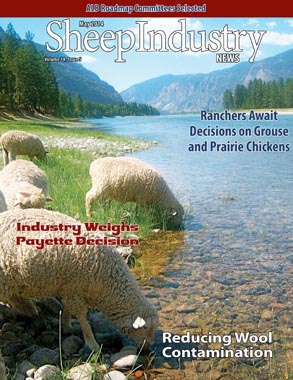
- May 2014
- President’s Notes
- Market Report
- Industry Weighs Payette Decision
- Producers Now Eligible for USDA Disaster Assistance
- ESA listing of Sage Grouse
- Parentage Test Could Benefit Sheep Producers
- Sheep Begin Fire Break Duties
- Don’t Let Your Farm be Fodder for Activists
- Reducing Contamination Vital to Wool Quality
- Data-Driven Approach
- ASI Awarded MAP, FMD Funding
- Obituaries
- Business Spotlight
- ASI News Briefs
- ALB Roadmap Committees Selected
Parentage Test Could Benefit Sheep Producers
RALPH LOOS
Sheep Industry News Editor
Understanding the idea that led to a new genomics-based parentage testing system for sheep is much simpler than understanding the science behind it.
One way to put it: with more accurate pedigrees, producers can make faster genetic progress and raise more, healthy sheep on less land with less labor.
Kreg Leymaster boiled it down even greater.
“It simply improves the odds of knowing the parents of a specific sheep,” Leymaster, a research geneticist with USDA’s Meat Animal Research Center (MARC), said.
Scientists with MARC are hoping the latest parental test will go further in helping not only producers, but others across the entire sheep industry.
“From a producer standpoint, the goal was to be able to have lambs born in an open pasture – and still be able to easily determine its parents,” Michael P. Heaton, Ph.D., a Genetics, Breeding, and Animal Health Researcher with MARC explained. “
In science speak, the goal of the research were “to identify parentage SNPs with exceptional qualities for use in globally diverse breeds and to develop a subset for use in North American sheep. “
A research paper on the new test was published in April. Meanwhile, MARC has technology- transferred the system to GeneSeek, a commercial genomic testing company based in Lincoln, Nebraska.
The research was primarily funded by USDA’s Agricultural Research Service.
Other than simply finding out who the sire or a lamb is – important in a multi-sire mating system – another benefit of the test is traceback assistance for disease purposes. Leymaster noted that producers could benefit from lower facility and labor outputs. For example, using the test to identify parentage would replace the need to ear-tag baby lambs at birth.
“From a practical standpoint, a sheep producer with access to this test no longer has to separate ewes and rams in order to determine parental lines,” Leymaster said. “Instead of using a single ram, a producer can use multiple rams, better assuring ewes are exposed to the best rams in the group. Determining the parental lines of a lamb can be done after the fact.”
As a result, with more accurate pedigrees, producers can make faster genetic progress and raise more, healthy sheep on less land with less labor.
Of course, “the success of genetic evaluations systems is directly affected by the accuracy of pedigrees,” Heaton added.
Scientists working on the tests said that although parentage can be accurately determined with single nucleotide polymorphisms (SNPs), the utility of a particular “parentage SNP” varies greatly among breeds.
“Our aims were to identify parentage SNPs with exceptional qualities for use in globally diverse breeds and then to develop a subset for use in North American sheep,” Heaton said. Exactly 163 parentage SNPs derived from the International Sheep Genomics Consortium were identified for widespread use in 74 breeds from 32 countries and/or islands. One subset of 109 parentage SNPs was developed for use in North American sheep and successfully tested in a USDA research flock. The new test is available through GeneSeek, which had it listed for about $19 per animal. Heaton noted that the science is available for the entire industry.
“One stipulations in this project was that it would be global, so anyone in the industry around the globe could use it,” he said.

